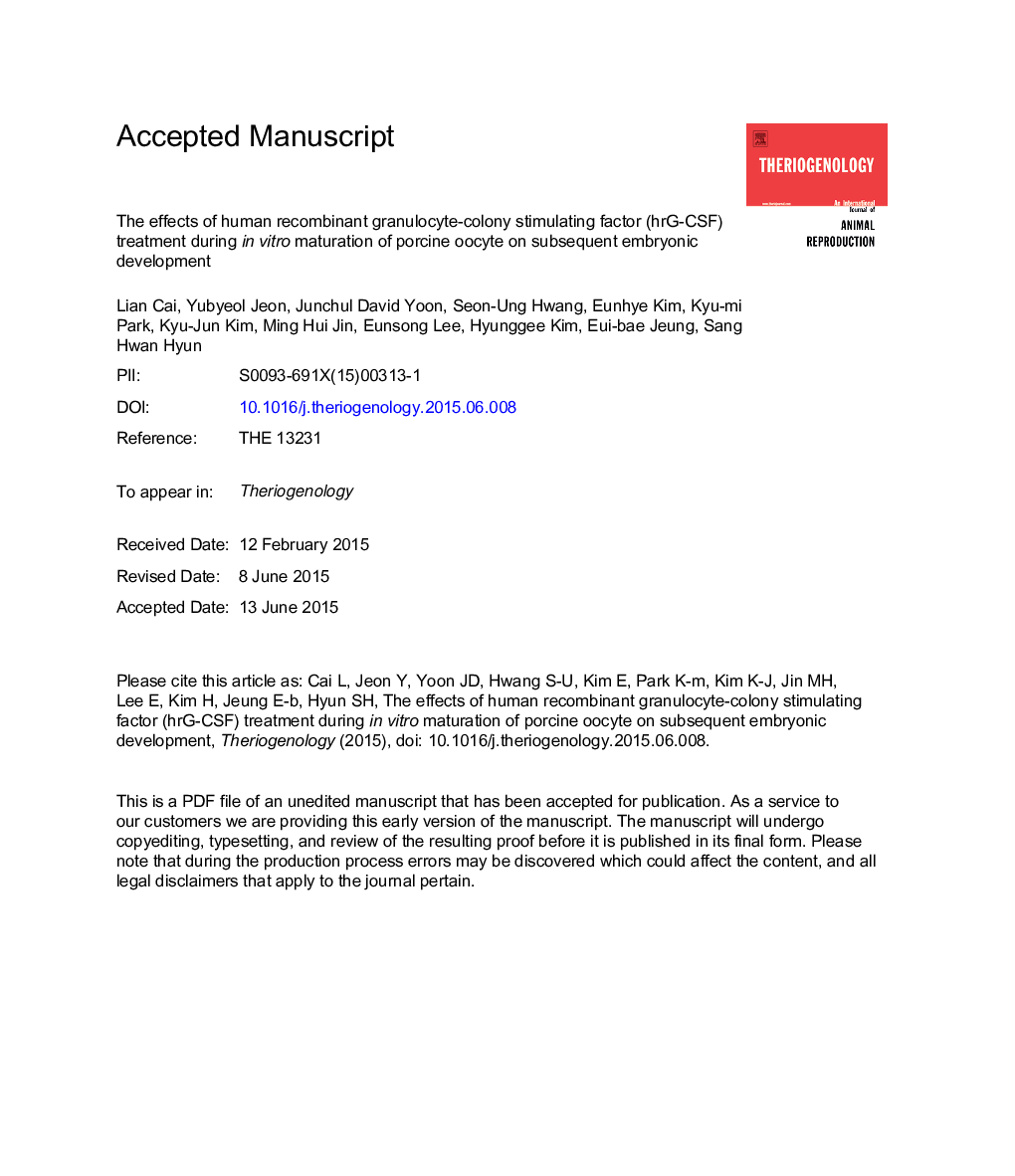| کد مقاله | کد نشریه | سال انتشار | مقاله انگلیسی | نسخه تمام متن |
|---|---|---|---|---|
| 10891679 | 1082059 | 2015 | 33 صفحه PDF | دانلود رایگان |
عنوان انگلیسی مقاله ISI
The effects of human recombinant granulocyte-colony stimulating factor treatment during in vitro maturation of porcine oocyte on subsequent embryonic development
ترجمه فارسی عنوان
اثرات درمان عامل فاکتور تحریک گرانولوسیت نوترکیب انسانی در بلوغ انسانی در رشد انسولین در رشد جنین
دانلود مقاله + سفارش ترجمه
دانلود مقاله ISI انگلیسی
رایگان برای ایرانیان
کلمات کلیدی
موضوعات مرتبط
علوم زیستی و بیوفناوری
علوم کشاورزی و بیولوژیک
علوم دامی و جانورشناسی
چکیده انگلیسی
Granulocyte colony-stimulating factor (G-CSF) is required for proliferation, differentiation, and survival of cells. It is also a biomarker of human oocyte developmental competence for embryo implantation. In humans, the G-CSF concentration peaks during the ovulatory phase of the ovarian cycle. In this study, the expressions of G-CSF and its receptor were analyzed by polymerase chain reaction in granulosa cells (GCs), CL, cumulus cells (CCs), and oocytes. Cumulus-oocyte complexes were aspirated from antral follicles of 1 to 3Â mm (small follicles) and 4 to 6Â mm (medium follicles). Cumulus-oocyte complexes from two kinds of follicles were matured in protein-free maturation medium supplemented with various concentrations of G-CSF (0, 10, and 100Â ng/mL). By real-time polymerase chain reaction, the expressions of G-CSF and its receptor were detected in GCs, CL, CCs, and oocytes. Interestingly, the G-CSF transcript levels were significantly lower in oocytes than in the other cell types, whereas the G-CSF receptor transcript levels in oocytes were similar to those in GCs. After 44Â hours of IVM, no differences in the rate of nuclear maturation were detected; however, the intracellular reactive oxygen species levels in oocytes from both groups of follicles matured with 10Â ng/mL of human recombinant G-CSF (hrG-CSF) groups were significantly lower (PÂ <Â 0.05). After parthenogenetic activation, the cleavage rates were significantly (PÂ <Â 0.05) higher in 100Â ng/mL hrG-CSF-treated small (63.3%) follicles than in 0, 10Â ng/mL hrG-CSF-treated small (38.6% and 49.0%, respectively) follicles and 0Â ng/mL hrG-CSF-treated medium (52.1%) follicles, and the cleavage rates were significantly (PÂ <Â 0.05) higher in 10Â ng/mL hrG-CSF-treated medium (76.3%) follicles than in all other groups. The blastocyst formation rates were significantly (PÂ <Â 0.05) higher in 100Â ng/mL hrG-CSF-treated small (31.2%) follicles than in 0 and 10Â ng/mL hrG-CSF small (10.4% and 15.6%, respectively) follicles, and the 10Â ng/mL hrG-CSF medium (45.7%) follicle was significantly (PÂ <Â 0.05) higher than in all other groups. The total cell number in blastocysts from the 10Â ng/mL hrG-CSF medium (106.5) follicles was significantly (PÂ <Â 0.05) increased compared to 0, 10, 100Â ng/mL hrG-CSF small (55.0, 73.7 and 59.5, respectively) follicles and 0, 100Â ng/mL hrG-CSF-treated medium (82.5 and 93.5, respectively) follicles. After IVF, the blastocysts stage was significantly (PÂ <Â 0.05) increased in 10Â ng/mL hrG-CSF-treated medium (36.4%) follicles. Fertilization efficiency was significantly high in 100Â ng/mL of small (29.1%) and 10Â ng/mL of medium (44.0%) follicles. We also examined the Bcl2 and ERK2 transcript levels and found that they were significantly higher in the small and medium follicle treatment groups. In conclusion, these results indicate that hrG-CSF improve the viability of porcine embryos.
ناشر
Database: Elsevier - ScienceDirect (ساینس دایرکت)
Journal: Theriogenology - Volume 84, Issue 7, 15 October 2015, Pages 1075-1087
Journal: Theriogenology - Volume 84, Issue 7, 15 October 2015, Pages 1075-1087
نویسندگان
Lian Cai, Yubyeol Jeon, Junchul David Yoon, Seon-Ung Hwang, Eunhye Kim, Kyu-mi Park, Kyu-Jun Kim, Ming Hui Jin, Eunsong Lee, Hyunggee Kim, Eui-bae Jeung, Sang Hwan Hyun,
